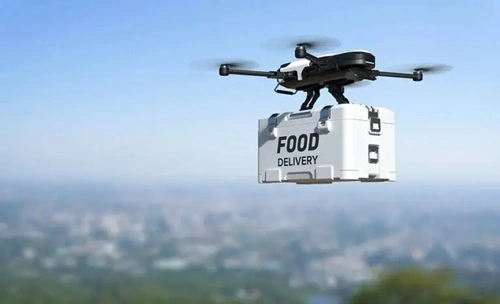Yes, drone delivery is legal in India, but it is subject to strict regulations under the Drone Rules, 2021, and requires adherence to guidelines issued by the Directorate General of Civil Aviation (DGCA). While drone delivery is still in its nascent stages, the Indian government has shown significant interest in promoting its use for logistics, healthcare, and e-commerce, provided all safety and regulatory requirements are met.
Legal Framework Governing Drone Delivery in India

- Drone Rules, 2021
- Introduced to streamline the use of drones for various purposes, including delivery services.
- The rules categorize drones based on their weight:
- Nano (up to 250 grams)
- Micro (250 grams to 2 kg)
- Small (2 kg to 25 kg)
- Medium (25 kg to 150 kg)
- Large (above 150 kg)
- For drone delivery, small and medium drones are commonly used.
- DGCA Guidelines for Drone Operations
- Drone operations are regulated by the Digital Sky Platform, where operators must register their drones and obtain necessary permits.
- For delivery services, operators require:
- Unique Identification Number (UIN) for the drone.
- Unmanned Aircraft Operator Permit (UAOP) for conducting operations.
- Permission for Beyond Visual Line of Sight (BVLOS) operations, as most delivery services rely on drones traveling beyond the operator’s direct view.
- No-Permission-No-Takeoff (NPNT) System
- Every flight must be approved via the NPNT system, ensuring real-time authorization for drone operations.
Key Requirements for Drone Delivery
- Drone Registration
- All drones must be registered on the DGCA’s Digital Sky Platform.
- Operators must obtain a Drone Acknowledgment Number (DAN) and the UIN.
- Pilot Certification
- Drone pilots must hold a Remote Pilot Certificate issued by DGCA-approved training organizations.
- Operational Zones
- Drones are allowed to operate in green zones (up to 400 feet) without special permissions.
- Operations in yellow zones (controlled airspace near airports) require ATC and DGCA approval.
- Red zones are restricted areas where drones cannot operate.
- BVLOS Permission
- Drone delivery often requires Beyond Visual Line of Sight operations. Special BVLOS trials are conducted to test and approve such services.
Drone Delivery Use Cases in India
- E-Commerce
- Companies like Flipkart and Amazon are exploring drone delivery to improve last-mile logistics, particularly in rural and remote areas.
- Healthcare
- Drones have been successfully used to deliver vaccines, medicines, and medical supplies in remote regions. For example:
- The Indian government’s Medicine from the Sky initiative in Telangana uses drones to deliver healthcare supplies.
- Drones have been successfully used to deliver vaccines, medicines, and medical supplies in remote regions. For example:
- Food Delivery
- Companies like Zomato and Swiggy have expressed interest in using drones for food delivery, aiming to reduce delivery times and costs.
- Agriculture and Logistics
- Drones are also being tested for transporting agricultural produce and essential goods.
Benefits of Drone Delivery
- Speed and Efficiency
- Reduces delivery times, especially for last-mile logistics in congested urban areas or remote locations.
- Cost-Effectiveness
- Drone delivery can lower transportation costs for small parcels and lightweight goods.
- Environmental Impact
- Reduces reliance on traditional vehicles, contributing to lower carbon emissions.
- Access to Remote Areas
- Drones can reach inaccessible regions, improving supply chain logistics and emergency response capabilities.
Challenges in Implementing Drone Delivery
- Regulatory Hurdles
- Obtaining permissions for BVLOS operations and ensuring compliance with the NPNT system can be time-consuming.
- Safety Concerns
- Risks of mid-air collisions, technical malfunctions, and theft during delivery need to be mitigated.
- Infrastructure
- India currently lacks the infrastructure for large-scale drone delivery operations, such as landing stations and charging points.
- Privacy Issues
- The use of drones raises concerns about data security and potential violations of privacy.
- Weather Dependency
- Adverse weather conditions can significantly affect drone operations.
Recent Developments in Drone Delivery
- BVLOS Trials
- In 2021, the DGCA approved BVLOS trials for several companies to assess the feasibility of drone delivery services in India.
- Successful trials in Telangana under the Medicine from the Sky project have paved the way for wider adoption.
- Government Initiatives
- The Indian government is actively promoting drone technology through schemes like the Production-Linked Incentive (PLI) Scheme for Drones and easing import restrictions for components.
- Drone Insurance
- Insurance for drones and operations is becoming a mandatory requirement to cover risks related to accidents, theft, or malfunctions.
Legal Consequences of Non-Compliance
- Fines and Penalties
- Operating a drone without registration or permits can attract penalties under the Aircraft Act, 1934, and DGCA rules.
- Unauthorized operations in restricted zones can result in heavy fines or imprisonment.
- Seizure of Equipment
- Authorities can confiscate drones used in illegal or unapproved operations.
- Criminal Charges
- Using drones for unlawful activities, such as smuggling or espionage, can lead to criminal charges under the Indian Penal Code (IPC).
Conclusion
Drone delivery is legal in India, with clear regulatory guidelines under the Drone Rules, 2021. While the technology has immense potential for revolutionizing logistics, healthcare, and e-commerce, its implementation requires compliance with DGCA rules and safety protocols. As the government continues to promote drone technology, India is poised to become a leader in drone-powered solutions. However, addressing infrastructure, safety, and privacy concerns will be crucial for the successful adoption of drone delivery services.
Hina Abbasi is Editor and a passionate sports and entertainment content writer at WinnersMaze.com. Hina’s expertise spans across a wide range of sports, and interest in many TV shows allowing her to deliver insightful analysis and compelling stories that resonate with readers.

